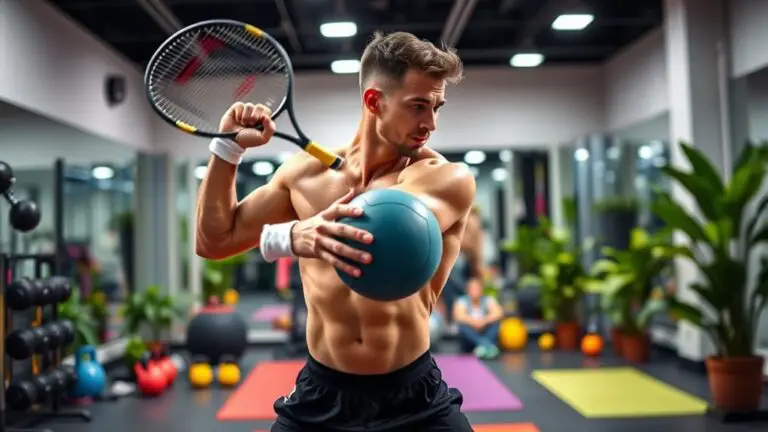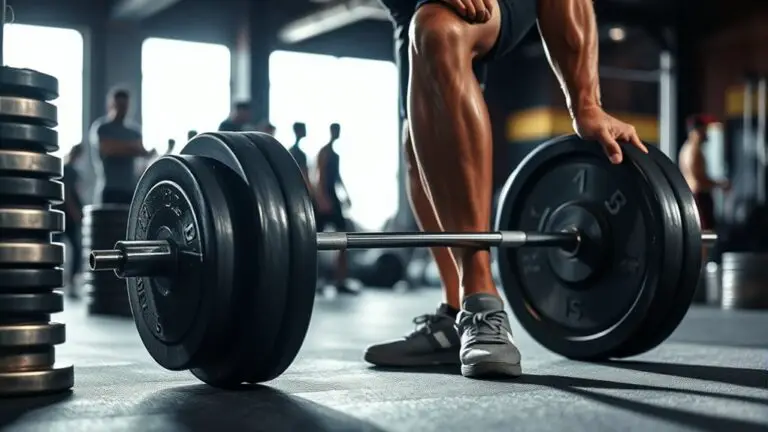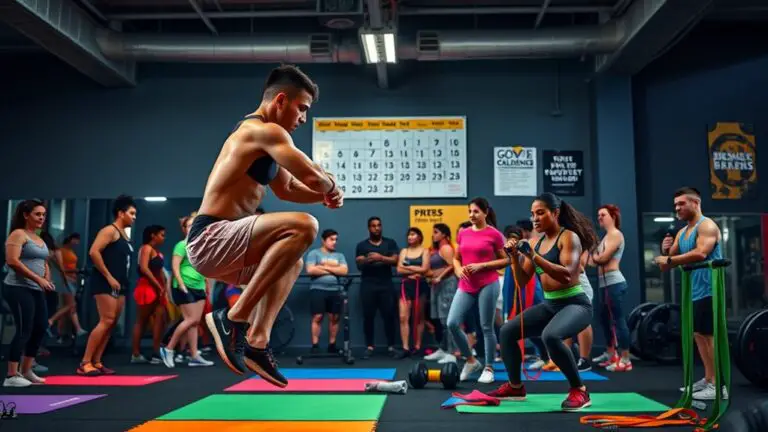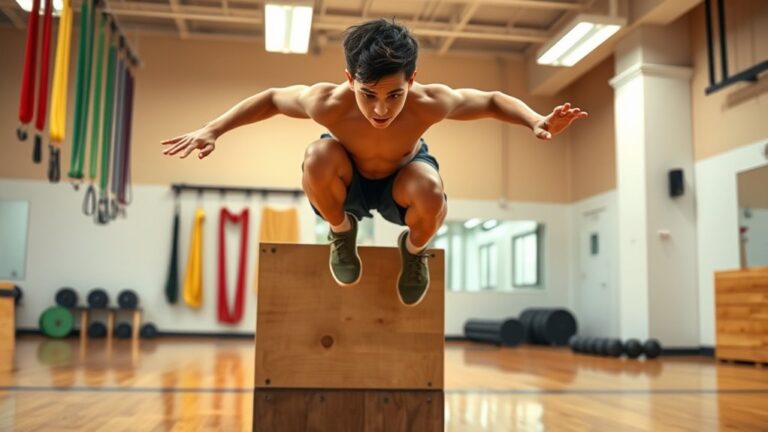The Best Gym Workouts for Horse Riders
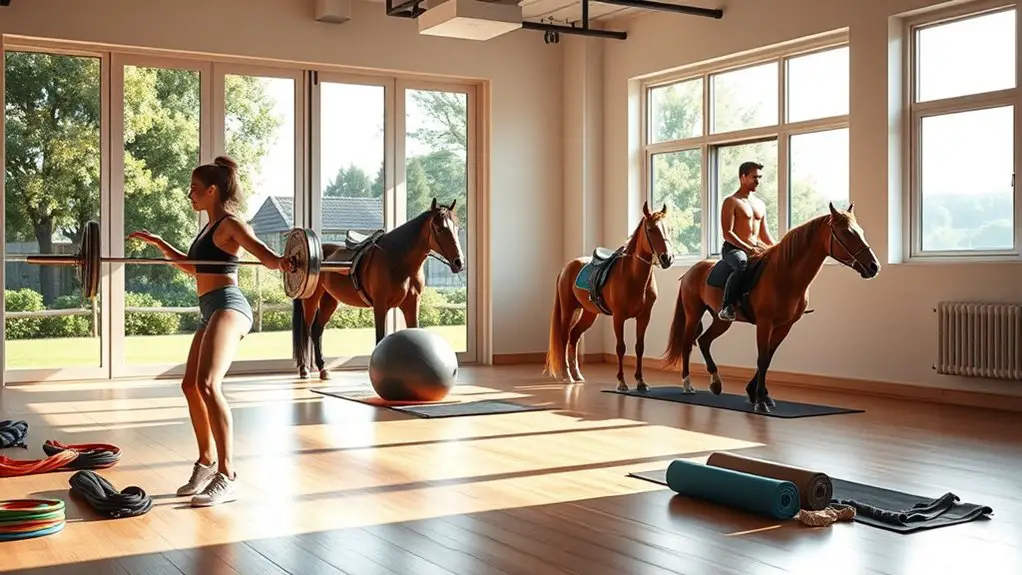
To enhance your riding performance, focus on gym workouts that boost strength, flexibility, and endurance. Core exercises like planks and bird-dogs improve stability. Incorporate lower body workouts, such as squats and lunges, to enhance posture and saddle control. Don’t forget upper body strength training with push-ups and rows for better rein management. Flexibility exercises and cardiovascular conditioning will keep you fit for longer rides. There’s more to discover about optimizing your workouts for riding success.
Importance of Fitness for Horse Riders
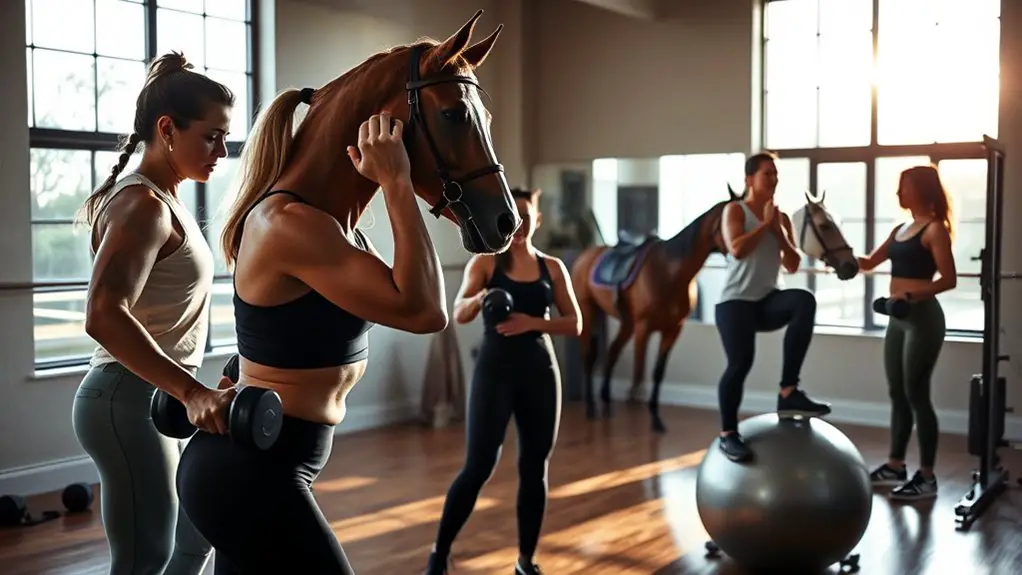
While it might seem that riding a horse is all about the animal’s strength and training, your fitness plays an essential role in the partnership. A well-conditioned rider can greatly enhance rider performance, ensuring better communication and control with the horse. When you’re physically fit, you’re more resilient and can endure longer rides without fatigue. This not only boosts your confidence but also helps maintain safety for both you and your horse.
Moreover, fitness benefits extend beyond endurance. Improved strength and flexibility allow you to maintain proper posture and balance in the saddle, which is vital for effective riding. When you’re strong and agile, you can respond quickly to your horse’s movements, reducing the risk of accidents. Prioritizing your fitness isn’t just about looking good; it’s about ensuring a harmonious and safe riding experience, fostering a deeper bond with your horse while mastering the art of riding.
Core Strengthening Exercises
A strong core is essential for any horse rider, as it directly impacts your stability and control in the saddle. Engaging in core strengthening exercises can help you maintain balance and improve your overall riding performance. Start with basic plank variations, such as the forearm plank and side plank, to build endurance and strength. Aim to hold each position for at least 30 seconds, gradually increasing the duration as you progress.
Incorporate stability exercises like bird-dogs and dead bugs, which promote coordination and balance. These moves not only strengthen your core but also enhance your body awareness, vital for reacting to your horse’s movements. Remember, a solid core can help prevent injuries, keeping you safe while riding. Make it a habit to include these exercises in your routine, and you’ll notice significant improvements in your riding skills and confidence. Stay safe and enjoy the ride!
Lower Body Workouts for Riders
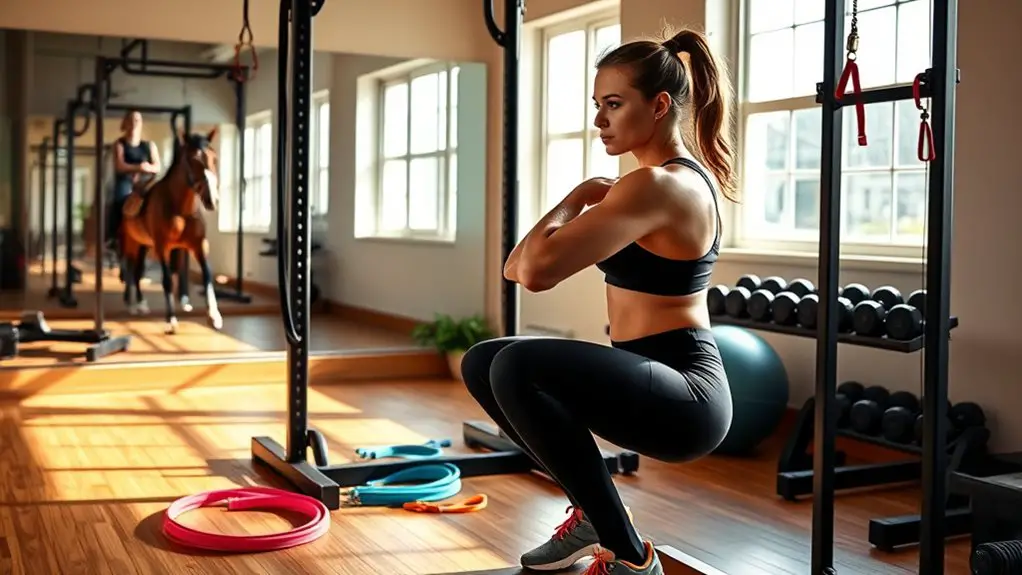
To excel in horseback riding, you can’t overlook the importance of strong lower body muscles, as they play a crucial role in your posture, balance, and ability to communicate effectively with your horse. Incorporating lower body workouts into your routine can enhance your riding performance and safety.
Consider these effective exercises:
- Squat variations: Strengthen your quads and glutes, improving stability in the saddle.
- Lunges: They offer numerous benefits, such as improved balance and coordination.
- Leg presses: Build overall leg strength for better control.
- Calf raises: Enhance your ankle stability, essential for maintaining proper leg position.
- Deadlifts: Strengthen your hamstrings, helping with your riding posture.
Integrating these workouts will help you develop the strength and stability needed for safe and effective riding. Remember to focus on form to prevent injuries and maximize your gains!
Upper Body Strength Training
When it comes to riding, upper body strength is just as vital as your legs. You need to focus on essential exercises that build strength in your arms, shoulders, and back, while also enhancing your core stability. This combination will help you maintain better control and balance in the saddle.
Essential Upper Body Exercises
Upper body strength is essential for horse riders, as it enhances control and stability while in the saddle. To improve your upper body strength training, consider incorporating these exercises into your routine:
- Push-ups: Build chest and shoulder strength, important for maintaining a secure grip on the reins.
- Pull-ups: Strengthen your back muscles, supporting better posture and balance.
- Dumbbell rows: Target those key muscles for improved coordination and stability.
- Plank to push-up: Enhance core and upper body strength while promoting overall stability.
- Seated shoulder press: Develop shoulder strength, significant for effective rein management.
Always focus on proper form and start with lighter weights to prevent injury. Your safety is paramount as you build the strength needed for better riding experiences.
Importance of Core Stability
Core stability is essential for horse riders, as it serves as the foundation for effective movement and balance in the saddle. When you engage your core, you enhance your ability to maintain proper posture and control while riding. This core engagement not only improves your stability but also helps prevent injuries, making your rides safer and more enjoyable.
Incorporating stability training into your workout routine can dramatically improve your performance. Exercises like planks and medicine ball rotations target your core, providing the strength needed for quick adjustments while riding. When your core is strong, you’ll find it easier to communicate with your horse, ensuring a more harmonious partnership. Prioritize core stability for a safer, more effective riding experience.
Flexibility and Mobility Routines
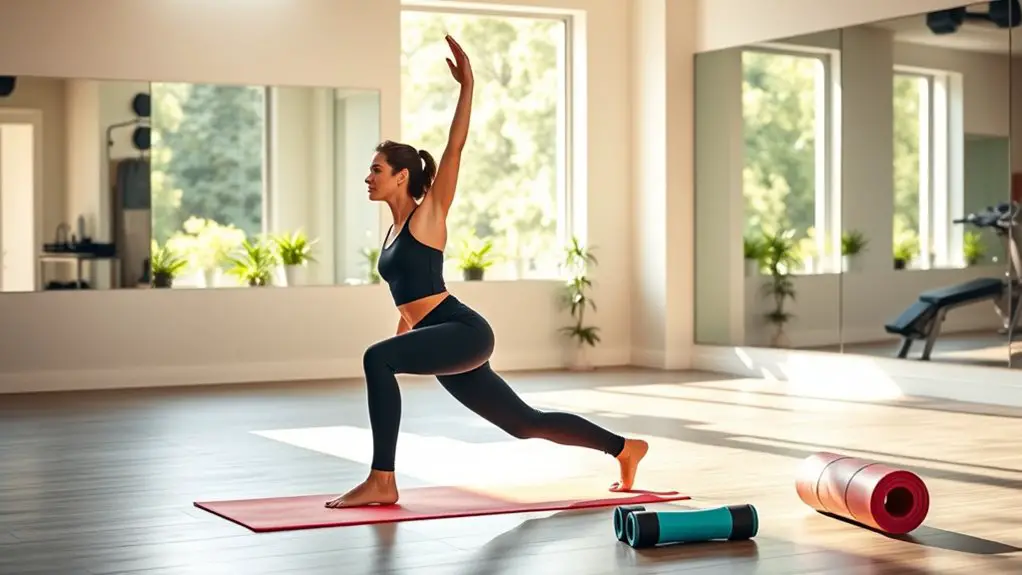
To guarantee you maintain ideal performance in the saddle, incorporating flexibility and mobility routines into your workout is essential. These routines not only enhance your riding but also help prevent injuries. Focus on dynamic stretching and yoga poses that target key muscle groups.
Consider integrating these elements into your routine:
- Leg swings to loosen your hip joints
- Cat-cow stretches for spinal flexibility
- Pigeon pose to open up the hips
- Seated forward bends for hamstring flexibility
- Shoulder rolls to alleviate tension
Balance and Stability Drills
To improve your riding, focusing on balance and stability is key. Core strength exercises, stability ball workouts, and balance board drills can help you develop better control and coordination. Let’s explore each of these drills and how they can enhance your performance in the saddle.
Core Strength Exercises
Building a strong core is essential for horse riders, as it enhances balance and stability in the saddle. Engaging your core and practicing core rotation can greatly improve your riding performance while ensuring your safety. Here are some effective core strength exercises to incorporate into your routine:
- Plank holds to build endurance and stability
- Russian twists for improved rotational strength
- Bird-dogs to enhance balance and coordination
- Side planks to target obliques and promote core engagement
- Medicine ball slams for dynamic core activation
Stability Ball Workouts
Core strength plays a significant role in enhancing your overall riding performance, but balance and stability are equally important. Using a stability ball can help you achieve these goals safely. Stability ball benefits include improved posture, core activation, and enhanced coordination. Start with simple dynamic stability exercises, like seated ball marches or hip lifts, to engage your core while maintaining balance. As you progress, try more challenging moves, like ball passes or planks with your hands on the ball. Always verify the ball is properly inflated and used on a flat surface to minimize risks. Incorporating these exercises into your routine will not only boost your riding skills but also promote greater safety while on horseback.
Balance Board Drills
While riding can be exhilarating, maintaining balance and stability is essential for both performance and safety. Balance board exercises are a fantastic way to enhance these skills. By incorporating these drills into your routine, you’ll reap numerous balance board benefits, such as improved coordination and core strength.
- Stand on the board with one foot while gently shifting your weight.
- Perform squats while balancing on the board to engage your legs and core.
- Try single-leg raises to challenge your stability further.
- Incorporate side-to-side movements to mimic the motion of riding.
- Use a resistance band while balancing to add an extra challenge.
These exercises not only build strength but also prepare you for the unpredictable nature of riding, ensuring you’re always safe in the saddle.
Cardiovascular Conditioning for Endurance
To excel in horseback riding, you’ll need strong cardiovascular conditioning to enhance your endurance. Focusing on your heart and lung capacity not only helps you ride longer but also improves your overall performance and safety. Incorporate aerobic exercises like running, cycling, or swimming into your routine; these activities build a solid endurance base.
Additionally, interval training can be particularly effective. By alternating between high-intensity bursts and lower-intensity recovery periods, you can boost your cardiovascular fitness in less time. For instance, try sprinting for 30 seconds, then walking for 1-2 minutes, repeating this cycle for about 20-30 minutes.
Always listen to your body during these workouts, ensuring you’re not overexerting yourself. Gradually increasing intensity and duration can help prevent injuries while maximizing benefits. With consistent cardiovascular training, you’ll find yourself riding with greater stamina and confidence.
Recovery and Injury Prevention Strategies
Injury prevention and recovery are essential aspects of maintaining your riding performance and overall well-being. By incorporating specific strategies into your routine, you can keep your body in peak condition while minimizing the risk of injury. Here are some effective approaches:
Incorporating injury prevention strategies is vital for enhancing your riding performance and overall health.
- Gentle stretching to improve flexibility and reduce muscle tightness.
- Foam rolling to release tension in your muscles and enhance blood flow.
- Active recovery days with low-impact activities like walking or swimming, promoting circulation and healing.
- Strength training focused on core stability to support your posture while riding.
- Proper hydration and nutrition to fuel your body and aid recovery.
Frequently Asked Questions
How Often Should Riders Work Out per Week?
When it comes to fitness frequency, finding the right rhythm is essential. You should aim for three to five workouts per week to guarantee workout consistency while prioritizing safety. This balanced approach helps build strength and stamina, making you a more effective rider. Listen to your body; if you’re tired or sore, don’t hesitate to take a rest day. Remember, progress isn’t just about pushing harder, it’s about training smarter!
What Equipment Is Essential for Gym Workouts?
When you’re considering essential equipment for gym workouts, focus on strength training and cardio equipment. You’ll want to incorporate free weights like dumbbells and resistance bands to build strength safely. For cardio, machines like treadmills or stationary bikes are great choices to improve endurance without injury risks. Always remember to start with lighter weights and proper form to prevent strain. With the right tools, you can create a balanced, effective workout routine.
Can Riders Benefit From Yoga or Pilates?
Absolutely, you can benefit from both yoga and pilates. They enhance flexibility, improve core strength, and promote balance—all essential for riding. Yoga benefits include increased mindfulness and relaxation, helping you stay calm in the saddle. Pilates advantages focus on stability and muscle control, reducing injury risks. By incorporating these practices, you’re not just strengthening your body; you’re also nurturing a focused and safe mindset for your riding experience.
Are There Specific Workouts for Different Riding Disciplines?
Yes, there are specific workouts tailored for different riding disciplines. For dressage training, focus on core stability and flexibility to enhance your posture and balance. In contrast, jumping strength workouts should emphasize explosive power and leg strength to improve your ability to clear obstacles. Always prioritize safety by ensuring you’re using proper techniques and equipment during your workouts, as this will help prevent injuries while you enhance your riding performance.
How to Stay Motivated to Maintain Fitness Routines?
Staying motivated to maintain your fitness routine can be challenging, but setting clear goals can really help. Break your larger goals into smaller, achievable milestones to keep you focused. Finding workout buddies can make a big difference too; they’ll support you and hold you accountable. Remember to prioritize safety in your routines, ensuring you’re not pushing limits too hard. Celebrate your progress together, and you’ll find it easier to stick with your fitness journey.
